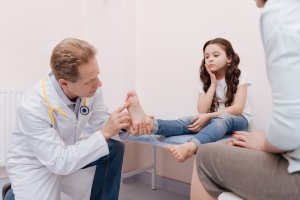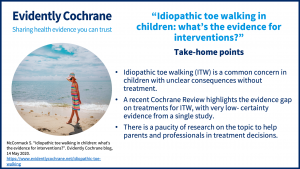In this blog for parents and health care professionals, Siobhan McCormack, a Paediatric Specialist Registrar, reviews the latest Cochrane evidenceCochrane Reviews are systematic reviews. In systematic reviews we search for and summarize studies that answer a specific research question (e.g. is paracetamol effective and safe for treating back pain?). The studies are identified, assessed, and summarized by using a systematic and predefined approach. They inform recommendations for healthcare and research. on idiopathic toe walking and explores the role of treatmentSomething done with the aim of improving health or relieving suffering. For example, medicines, surgery, psychological and physical therapies, diet and exercise changes..
Page last checked 26 June 2023
Take-home points
Idiopathic toe walking involves healthy children who persist in walking on their toes beyond the point they should typically achieve a heel-toe walking pattern, when specific causes have been excluded. Idiopathic toe walking is common, affecting up to five percent of children (Engström and Tedroff, 2012) – and children make up around a quarter of the world!
Toe walking in children is a cause for concern for parents and health care professionals. The longer-term consequences if idiopathic toe walking is persistent and untreated are unclear, limiting the available evidence to support therapies to improve it. Parents are often keen for any interventionA treatment, procedure or programme of health care that has the potential to change the course of events of a healthcare condition. Examples include a drug, surgery, exercise or counselling. that may help their child. For children with a specific cause, such as a neurological, neuromuscular or orthopaedic impairment, further investigation and treatment can be targeted. Treatments can vary from physiotherapy techniques and exercises, footwear, insoles, splints and casts to more specialised surgeries or botulinum toxin (BTX) injection to the calf muscles.

All interventions are largely aimed at improving restricted ankle movement and can be invasive, intensive and costly and they should be evidence based for the benefit of children, parents and healthcare systems
A Cochrane ReviewCochrane Reviews are systematic reviews. In systematic reviews we search for and summarize studies that answer a specific research question (e.g. is paracetamol effective and safe for treating back pain?). The studies are identified, assessed, and summarized by using a systematic and predefined approach. They inform recommendations for healthcare and research. published in October 2019 hoped to examine the effect of conservative and surgical interventions for idiopathic toe walking in children with toe walking for at least six months, primarily on normalisation of gait pattern (children walking on their toes less than half of the time as perceived by their parents), along with exploring improvements in range of movement at the ankle, pain, adverse effects of treatment and recurrence of toe walking.
What was the evidence before the Cochrane Review?
A 2014 non-Cochrane systematic review on treatment for idiopathic toe walking found only one randomised controlled trialA trial in which the people taking part are randomly divided into groups. A group (the intervention group) is given the intervention being tested (for example a drug, surgery, or exercise) and compared with a group which does not receive the intervention (the control group)., deemed to be at high grade evidence, and 18 observational studiesA study in which the researchers look at what happens over time to groups of people. They study changes or differences in one characteristic (e.g. whether or not people smoke) in relation to changes or differences in another characteristic (e.g. whether or not they get cancer)., deemed to be low grade evidence. More than half the studies were retrospective and most incorporated small sample sizes, leading to substantial riskA way of expressing the chance of an event taking place, expressed as the number of events divided by the total number of observations or people. It can be stated as ‘the chance of falling were one in four’ (1/4 = 25%). This measure is good no matter the incidence of events i.e. common or infrequent. of biasAny factor, recognised or not, that distorts the findings of a study. For example, reporting bias is a type of bias that occurs when researchers, or others (e.g. drug companies) choose not report or publish the results of a study, or do not provide full information about a study..
Several treatment programmes and varying follow-up periods were described at the time and although it was suggested that preliminary evidence was in favour of a benefit of serial casting, surgery and botulinum toxin (BTX) injection it was felt overall that the quality of the evidenceThe certainty (or quality) of evidence is the extent to which we can be confident that what the research tells us about a particular treatment effect is likely to be accurate. Concerns about factors such as bias can reduce the certainty of the evidence. Evidence may be of high certainty; moderate certainty; low certainty or very-low certainty. Cochrane has adopted the GRADE approach (Grading of Recommendations Assessment, Development and Evaluation) for assessing certainty (or quality) of evidence. Find out more here: https://training.cochrane.org/grade-approach was generally poor.
What did the Cochrane Review find?
Four trialsClinical trials are research studies involving people who use healthcare services. They often compare a new or different treatment with the best treatment currently available. This is to test whether the new or different treatment is safe, effective and any better than what is currently used. No matter how promising a new treatment may appear during tests in a laboratory, it must go through clinical trials before its benefits and risks can really be known. were initially included in the Cochrane review. Two studies examining the use of footwear, splints and exercises with and without BTX injection had insufficient dataData is the information collected through research. for analysis and one, examining orthoses, lacked appropriate follow-up data, leaving a single studyAn investigation of a healthcare problem. There are different types of studies used to answer research questions, for example randomised controlled trials or observational studies. to use for data extraction.
This study was a randomisedRandomization is the process of randomly dividing into groups the people taking part in a trial. One group (the intervention group) will be given the intervention being tested (for example a drug, surgery, or exercise) and compared with a group which does not receive the intervention (the control group). , controlled, parallel‐group trial with 47 children that investigated BTX injection followed by serial casting versus casting alone. The review authors found very low certainty evidence for all outcomesOutcomes are measures of health (for example quality of life, pain, blood sugar levels) that can be used to assess the effectiveness and safety of a treatment or other intervention (for example a drug, surgery, or exercise). In research, the outcomes considered most important are ‘primary outcomes’ and those considered less important are ‘secondary outcomes’.. Both groups of children had improved from baseline at 12 months follow-up with no clear evidence of a difference between intervention arms. There was also little to no evidence of a difference in ankle range of movement or in recurrence of toe walking between the two groups of children.
There was no evidence of a difference in adverse events across the groups and they did not lead to discontinuation of therapy for any child. Calf pain was reported in two children of the casting-only group and three in the casting-plus-BTX group with three minor skin problems in each.
What is the bottom line?
The Cochrane Review has highlighted a disappointing lack of reliable evidence to inform choices about treatments for idiopathic toe-walking. Very low-certainty evidence for intervention in idiopathic toe walking from a single small study means that the effects of treatment remain uncertain.
What next?
This review highlights our unmet need for high-quality, well designed, randomised controlled studiesA trial in which a group (the ‘intervention group’) is given a intervention being tested (for example a drug, surgery, or exercise) is compared with a group which does not receive the intervention (the ‘control group’). of commonly employed treatments with adequate follow up to guide interventions for children with idiopathic toe walking.
A blinded, randomised controlled trial investigating the effect of physiotherapy techniques including muscle strengthening in children with idiopathic toe walking is ongoing in Brazil and the results of this may add to the current knowledge base.
Join in the conversation on Twitter with @siobhanmccorm @CochraneUK or leave a comment on the blog. Please note, we will not publish comments that link to commercial sites or appear to endorse commercial products.
Siobhan McCormack has nothing to disclose.




Hi
This indeed is a very limited brief coverage as it didn’t say why it is a cause for concern for parents or children..
Sadly I found this to be a very medical model of inquiry
A bit more information about any risks of injury if you don’t intervene.. ?
Im a Podiatrist with years of experience with Disability and Im left wondering Pediatrician’s actually advise parents when and if they are concerned about this probably other professionals may look to the Pediatric community for some insight into children’s foot behaviour and foot health ?
Perhaps it is something you could look into as PHD..?
It really concerns me that no injuries from toe walking have been reported and yet they consider injection toxin into children’s feet.
Dawn Shailer / May 16, 2020